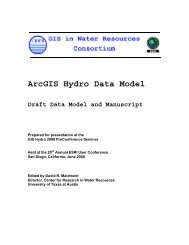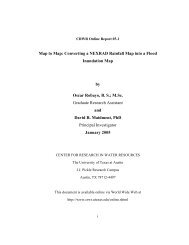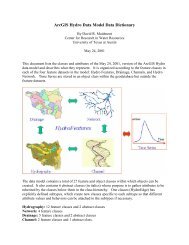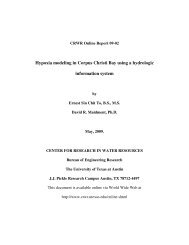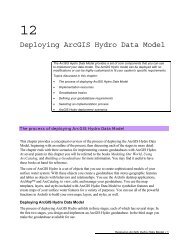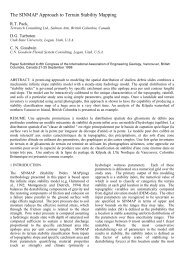View the Whole Report - Center for Research in Water Resources ...
View the Whole Report - Center for Research in Water Resources ...
View the Whole Report - Center for Research in Water Resources ...
You also want an ePaper? Increase the reach of your titles
YUMPU automatically turns print PDFs into web optimized ePapers that Google loves.
ema<strong>in</strong><strong>in</strong>g 10% ranged from 15 to 50 µm (0.015 to 0.050 mm). This particle distribution<br />
was skewed to <strong>the</strong> smaller sizes as compared with <strong>the</strong> parent soil. Conspicuous delta<br />
<strong>for</strong>mation <strong>in</strong> certa<strong>in</strong> locations <strong>in</strong>dicated that sand sized particles were transported to <strong>the</strong><br />
bas<strong>in</strong>s and represented a m<strong>in</strong>or constituent of <strong>the</strong> total particle load. However, <strong>the</strong>se<br />
particles were not detected through grab sampl<strong>in</strong>g and analysis methods because of <strong>the</strong><br />
tendency to saltate along <strong>the</strong> bottom of flow channels and settle rapidly.<br />
The computed IRE ranged from -293% to 100%. Schueler and Lugbill (1990)<br />
estimated that sediment bas<strong>in</strong>s will remove approximately 50% of <strong>the</strong> total suspended<br />
particle load and less than 15% of turbidity. Approximately 60% of total settl<strong>in</strong>g<br />
occurred with<strong>in</strong> six hours, and <strong>the</strong> settl<strong>in</strong>g rates decreased dramatically beyond that po<strong>in</strong>t<br />
<strong>in</strong> time. The median sedimentation rate observed was 104 mm per hour. Sediment<br />
removal capabilities were highest <strong>for</strong> early stages of construction and storm events of less<br />
than 19 mm of ra<strong>in</strong>fall.<br />
Runoff conta<strong>in</strong><strong>in</strong>g a monodispersed sediment (diameter of 0.2 mm and settl<strong>in</strong>g<br />
velocity of approximately 10 cm/s) was used <strong>in</strong> laboratory flume tests by Kouwen (1990).<br />
These solids deposited <strong>in</strong> <strong>the</strong> flume as <strong>the</strong> velocity of runoff decreased and <strong>the</strong> water<br />
<strong>for</strong>med a pool. Silt fence fabrics, burlap, straw bales, and rock berms also were tested<br />
and filter<strong>in</strong>g efficiencies greater than 95% were reported <strong>for</strong> three silt fence fabrics<br />
(Carthage FX300C, Terrafix 370RS, and Exxon 100S). Kouwen (1990) noted that flowthrough<br />
rates <strong>in</strong> flume tests ranged from 6.9 L/s/m 2 <strong>for</strong> a silt fence fabric to 127 L/s/m 2 <strong>for</strong><br />
burlap.<br />
2.5 Rock Berms<br />
Rock filter dams or rock berms are mounds of graded rock placed on a contour to<br />
<strong>in</strong>tercept runoff, reta<strong>in</strong> sediment and create sheet flow by dispers<strong>in</strong>g <strong>the</strong> stormwater over<br />
a wider area. Rocks used <strong>in</strong> <strong>the</strong> berms typically are 7.5 cm - 15 cm <strong>in</strong> diameter. TxDOT<br />
(1992a) recommends a maximum runoff flow rate per submerged area of rock berm of 40<br />
L/s . m 2 . Rock berms at times are preferred over silt fences because of lower ma<strong>in</strong>tenance<br />
requirements and cost. They also are better suited <strong>for</strong> use <strong>in</strong> channels or ditches with<br />
concentrated flow.<br />
15




